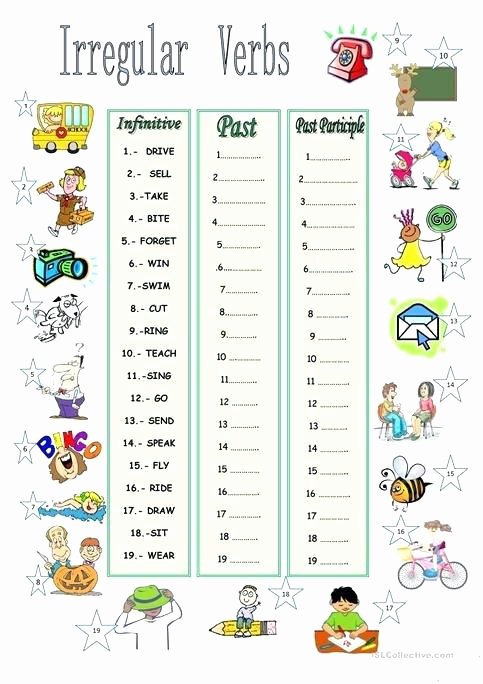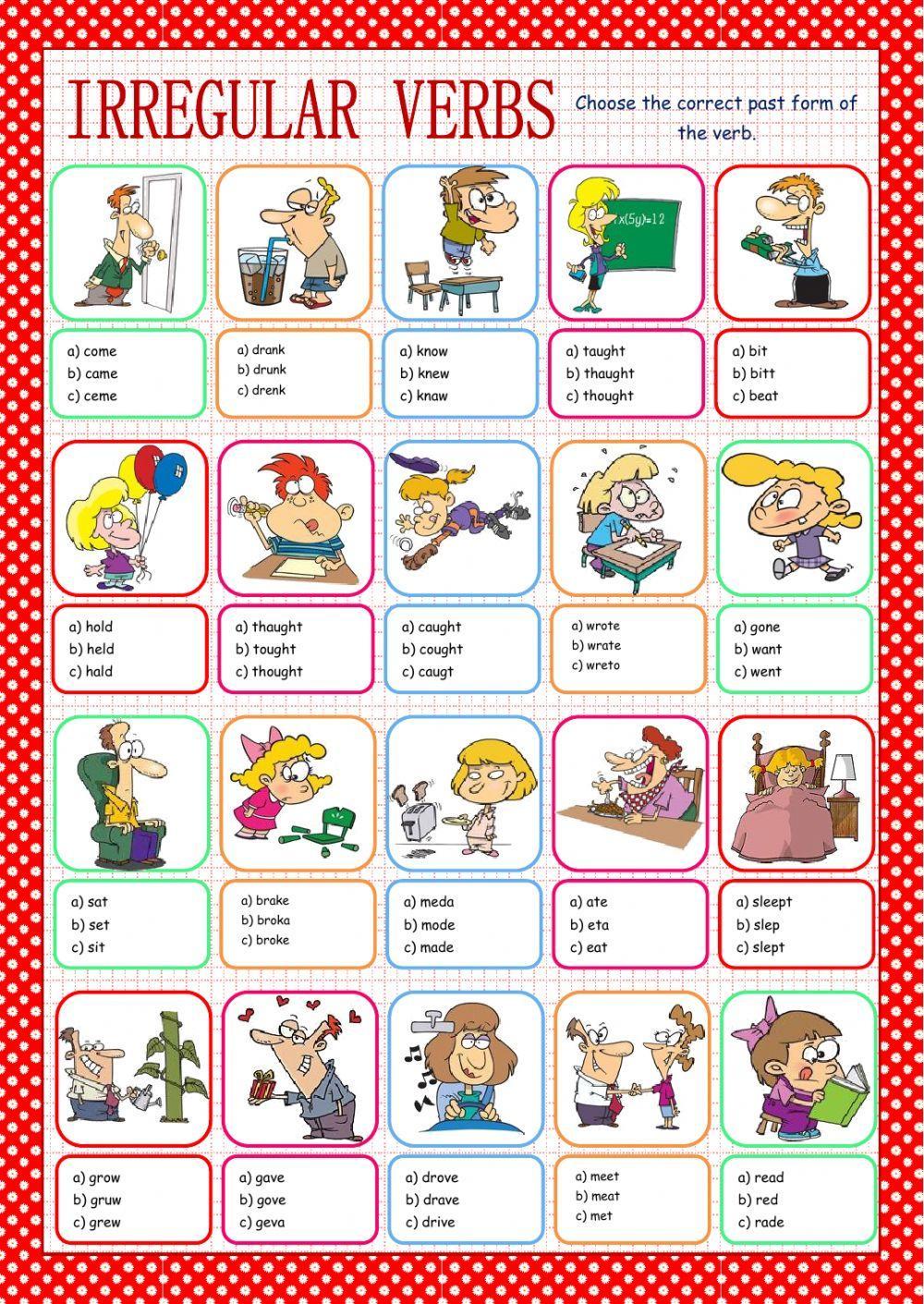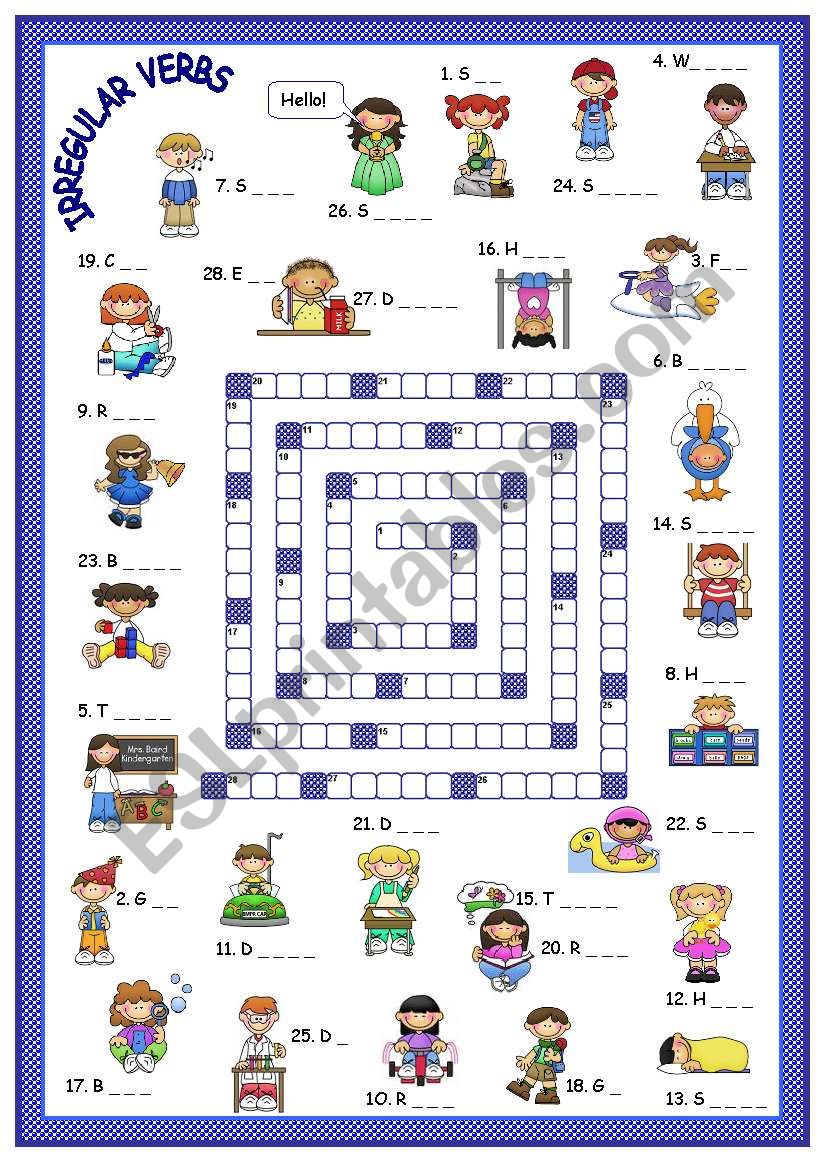
Mastering the Maze: The Indispensable Role of Irregular Verbs Worksheets in Language Acquisition
English, with its global reach and intricate nuances, presents a fascinating challenge for learners worldwide. While many aspects of its grammar follow predictable patterns, one particular area often proves to be a stumbling block: irregular verbs. Unlike their regular counterparts, which simply add "-ed" to form their past simple and past participle forms (e.g., walk, walked, walked), irregular verbs defy such neat categorization. Their forms change in unpredictable ways (e.g., go, went, gone; see, saw, seen; eat, ate, eaten), demanding memorization rather than rule application. This inherent unpredictability makes them a formidable hurdle, yet mastering them is crucial for fluent and accurate communication. This is where Irregular Verbs Worksheets emerge as an invaluable, indeed often indispensable, tool in the language learning arsenal.
This comprehensive article will delve into the profound importance of irregular verbs, explore why they pose such a significant challenge, and, most importantly, highlight the multifaceted benefits and diverse applications of Irregular Verbs Worksheets in facilitating their acquisition. We will discuss various types of worksheets, effective design principles, strategies for integrating them into a holistic learning approach, and tips for both learners and educators to maximize their impact.
The Enigma of Irregular Verbs: Understanding the Challenge

At the heart of English grammar lies the verb, the action word that drives sentences. Verbs change their form to indicate tense, mood, and voice. When it comes to past tenses and perfect tenses, English distinguishes between regular and irregular verbs. Regular verbs, thankfully, are straightforward. Add "-ed" for the simple past and past participle, and you’re done. Play becomes played, talk becomes talked, finish becomes finished.

Irregular verbs, however, inherited their quirks from Old English and other Germanic languages, resisting the standardization that swept through much of the language. They represent a linguistic legacy, a testament to the organic evolution of language. Their past simple and past participle forms can involve:
- Vowel changes: Sing, sang, sung; run, ran, run.
- Consonant changes: Build, built, built; send, sent, sent.
- No change at all: Cut, cut, cut; put, put, put.
- Completely different forms: Go, went, gone; be, was/were, been.


The sheer number of these verbs – estimates range from 200 to 300, depending on what constitutes "common" usage – combined with their lack of a consistent pattern, makes them a significant memorization task. For non-native speakers, this often leads to common errors such as "I goed to the store" instead of "I went to the store," or "She seen it" instead of "She saw it." These errors, while understandable, can hinder comprehension and mark a speaker as less proficient. Therefore, dedicated and systematic practice is not merely helpful; it is essential.

The Unrivaled Efficacy of Irregular Verbs Worksheets
In a world increasingly dominated by digital apps and interactive platforms, the humble worksheet might seem antiquated. However, its enduring power in language learning, particularly for irregular verbs, is undeniable. Worksheets provide a structured, tangible, and repeatable method for practicing and solidifying knowledge. They transform passive learning (e.g., just reading a list of verbs) into active engagement, which is far more effective for long-term retention.

Irregular Verbs Worksheets are not just about rote memorization; they are about pattern recognition, contextual application, and reinforcing correct usage through repetition. They allow learners to:
- Engage Actively: Rather than passively absorbing information, learners must actively recall and apply the correct verb forms. This active retrieval strengthens neural pathways and improves memory.
- Receive Immediate Feedback: Many worksheets come with answer keys, allowing learners to self-correct and understand their mistakes instantly. This immediate feedback loop is critical for effective learning.
- Practice Systematically: Worksheets can be designed to focus on specific groups of irregular verbs (e.g., those with similar patterns), allowing for targeted practice and gradual mastery.
- Reinforce Through Repetition: The beauty of worksheets lies in their reusability (if printed) or the ability to do similar exercises multiple times. Spaced repetition, a proven learning technique, can be easily implemented through a series of worksheets.
- Build Confidence: Successfully completing exercises on a worksheet provides a sense of accomplishment, boosting a learner’s confidence in their ability to use irregular verbs correctly.


A Spectrum of Engagement: Types of Irregular Verbs Worksheets
The versatility of worksheets is one of their greatest strengths. They can be designed in numerous formats to cater to different learning styles and target specific aspects of irregular verb mastery. Here are some common and highly effective types:
-
Fill-in-the-Blanks: This classic format presents sentences with a blank where the correct form of an irregular verb needs to be inserted. The infinitive form is usually provided in parentheses.
- Example: "Yesterday, I (go) to the market and (buy) some fresh fruit."
- Benefit: Focuses on direct recall and contextual application.
-
Matching Exercises: Learners match the infinitive form of a verb to its simple past and/or past participle forms.
- Example: Column A (Infinitive) | Column B (Past Simple) | Column C (Past Participle)
- See | Went | Built
- Go | Saw | Seen
- Build | Built | Gone
- Benefit: Excellent for initial memorization and reinforcing the three forms simultaneously.
- Example: Column A (Infinitive) | Column B (Past Simple) | Column C (Past Participle)
-
Sentence Transformation: Learners rewrite sentences, changing the tense from present to past simple or present perfect, requiring them to correctly transform the irregular verb.
- Example: "I eat breakfast every morning." -> "Yesterday, I ____ breakfast."
- Benefit: Develops flexibility in usage and understanding of tense changes.
-
Error Correction: Sentences are provided with intentionally incorrect irregular verb forms, and learners must identify and correct them.
- Example: "He runned very fast." -> "He ran very fast."
- Benefit: Enhances critical thinking and reinforces correct usage by highlighting common mistakes.
-
Contextual Practice (Reading Passages): Worksheets can feature short stories or paragraphs with blanks for irregular verbs. This forces learners to consider the narrative context.
- Example: "Once upon a time, a brave knight (fight) a dragon. He (throw) his sword, but it ____ (hit) the wall instead."
- Benefit: Promotes understanding of how irregular verbs function within a larger text.
-
Creative Writing Prompts: Learners are given a list of irregular verbs and tasked with writing a short story or paragraph that incorporates them.
- Example: "Write a story using at least five of these verbs: break, sleep, feel, think, begin."
- Benefit: Encourages active production and deepens understanding through personal application.
-
Crosswords and Word Searches: While less direct, these can be fun ways to reinforce spelling and recognition of irregular verb forms.
- Benefit: Adds an element of gamification and visual learning.
-
Quizzes/Assessments: Designed to test overall knowledge, these can combine various exercise types and often serve as a measure of progress.
- Benefit: Provides a snapshot of mastery and identifies areas needing further practice.
The Multifaceted Benefits of Integrating Irregular Verbs Worksheets into Learning
Beyond the general efficacy, the specific advantages of using Irregular Verbs Worksheets are numerous and contribute significantly to overall language proficiency:
- Reinforcement and Retention: Consistent practice through worksheets helps to cement irregular verb forms in long-term memory, preventing them from being forgotten easily.
- Active Recall: Each time a learner completes a blank or transforms a sentence, they are actively retrieving information from memory, a process far more effective than passive review.
- Error Identification and Correction: Worksheets provide a safe space for making mistakes and, crucially, correcting them. This iterative process of trial and error is fundamental to learning.
- Self-Paced Learning: Learners can work through worksheets at their own speed, revisiting difficult verbs as many times as needed without feeling rushed or held back by others.
- Targeted Practice: Worksheets can be designed to focus on specific verb groups (e.g., verbs with vowel changes, verbs with no change), allowing for concentrated effort where it’s most needed.
- Vocabulary Expansion: As learners encounter irregular verbs in different contexts, their overall vocabulary naturally expands.
- Confidence Building: Successfully completing exercises and seeing tangible progress on paper significantly boosts a learner’s confidence in their ability to use English correctly.
- Practical Application: Many worksheets place verbs within realistic sentences or scenarios, helping learners understand how these verbs are used in everyday communication, not just in isolation.
- Preparation for Higher-Level Grammar: A strong foundation in irregular verbs is essential for mastering more complex tenses like the present perfect, past perfect, and conditional sentences.
Crafting Excellence: Designing Effective Irregular Verbs Worksheets
For educators, parents, or even self-learners creating their own materials, thoughtful design is key to maximizing the effectiveness of worksheets:
- Clear Instructions: Ambiguous instructions can lead to frustration. Ensure every task is clearly explained.
- Varied Formats: Mix and match exercise types to keep learners engaged and address different aspects of verb mastery.
- Gradual Difficulty: Start with simpler, more common verbs and less complex sentence structures, gradually increasing the challenge.
- Contextual Relevance: Whenever possible, embed verbs in meaningful sentences or short paragraphs that are relatable to the learner.
- Answer Keys: Providing an answer key allows for immediate self-correction and reduces reliance on an instructor.
- Visual Appeal: Well-organized layouts, clear fonts, and perhaps some relevant images can make worksheets more inviting.
- Focus on Common Verbs First: Prioritize the most frequently used irregular verbs (e.g., be, have, do, say, go, get, make, know, think, take) before moving to less common ones.
- Spaced Repetition: Design a series of worksheets that revisit previously learned verbs at increasing intervals to enhance long-term retention.
Beyond the Page: Integrating Worksheets into a Holistic Learning Strategy
While incredibly effective, worksheets should ideally be part of a broader, more dynamic learning approach. They complement other activities, creating a synergistic effect:
- Pair with Listening and Speaking: After completing a worksheet, encourage learners to use the verbs in spoken sentences or role-playing activities. Listen for irregular verbs in podcasts, movies, or conversations.
- Utilize Flashcards and Apps: Digital flashcard systems (like Anki or Quizlet) can be powerful tools for spaced repetition, especially when combined with the structured practice of worksheets.
- Read Extensively: Encountering irregular verbs naturally in books, articles, and stories helps learners internalize their correct usage in context.
- Maintain Consistency: Regular, even short, practice sessions are more effective than infrequent, long ones. Make irregular verb review a daily or weekly habit.
- Create Personal Sentences: Encourage learners to write their own sentences using new irregular verbs, making the learning more personal and memorable.
Empowering the Learner: Tips for Maximizing Your Irregular Verbs Worksheets Experience
For individuals embarking on the journey of mastering irregular verbs, here are some actionable tips:
- Don’t Just Memorize, Understand: While memorization is key, try to notice any subtle patterns (e.g., verbs ending in -ought/-aught like teach-taught-taught, buy-bought-bought).
- Practice Regularly: Short, consistent sessions are more effective than cramming. Dedicate 10-15 minutes daily or every other day to worksheets.
- Use a Dictionary: If you’re unsure about a verb’s form or meaning, look it up. Many dictionaries provide the principal parts of irregular verbs.
- Create Your Own Sentences: After completing a worksheet, try to create five new sentences using some of the verbs you just practiced.
- Review Your Mistakes: Don’t just check the answers and move on. Understand why you made a mistake and review the correct form multiple times.
- Find a Study Partner: Practice with a friend. Quiz each other, or correct each other’s sentences.
- Celebrate Small Victories: Acknowledge your progress. Each correctly used irregular verb is a step closer to fluency.
For the Guides: Maximizing the Impact of Irregular Verbs Worksheets in Education
For teachers, tutors, and parents guiding learners, here’s how to make worksheets even more impactful:
- Assess Needs: Before assigning worksheets, gauge your students’ current level of understanding to select appropriate difficulty.
- Provide Constructive Feedback: Go beyond just marking right or wrong. Explain why an answer is incorrect and offer tips for improvement.
- Make it Fun: Incorporate games, challenges, or competition to make the learning process more enjoyable.
- Vary Activities: Don’t rely solely on one type of worksheet. Rotate between matching, fill-in-the-blanks, transformation, and creative writing.
- Encourage Self-Correction: Teach students how to use an answer key effectively and how to learn from their own mistakes.
The Evolving Landscape: Worksheets in the Digital Age
While traditional paper-based worksheets remain highly effective, the digital age has also brought forth a plethora of online Irregular Verbs Worksheets and interactive exercises. Websites like EnglishClub, ESL-Lounge, and many educational platforms offer printable PDFs as well as interactive quizzes where learners can type in answers and receive instant feedback. This blend of traditional and digital resources offers unparalleled flexibility and accessibility for learners worldwide. Interactive worksheets often include audio components, enhancing listening skills alongside grammar.
Conclusion
In the vast and sometimes daunting journey of mastering English irregular verbs, Irregular Verbs Worksheets stand out as an indispensable tool. Their structured nature, capacity for active engagement, and emphasis on repetitive practice make them profoundly effective for memorizing, understanding, and correctly applying these challenging verb forms. From the foundational fill-in-the-blanks to more complex contextual exercises, these worksheets offer a versatile and accessible pathway to proficiency.
By strategically incorporating a variety of these worksheets into a broader learning strategy – complemented by listening, speaking, reading, and consistent review – learners can systematically conquer the complexities of irregular verbs. Whether you are a student striving for accuracy, an educator designing lesson plans, or a parent supporting your child’s language journey, the strategic use of well-designed Irregular Verbs Worksheets is a proven method to transform a significant linguistic challenge into a conquered skill, paving the way for more confident and articulate English communication. Embrace the power of the worksheet, and unlock the full potential of your English learning adventure.
